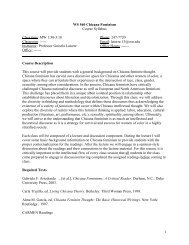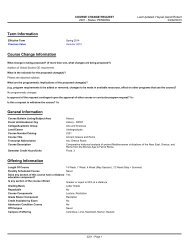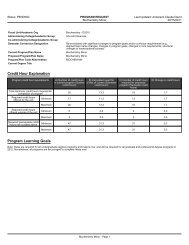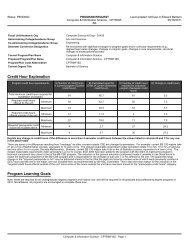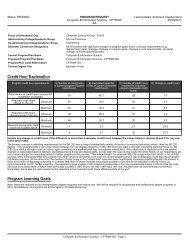COURSE SYLLABUS Art Education 367.03 Criticizing Television ...
COURSE SYLLABUS Art Education 367.03 Criticizing Television ...
COURSE SYLLABUS Art Education 367.03 Criticizing Television ...
Create successful ePaper yourself
Turn your PDF publications into a flip-book with our unique Google optimized e-Paper software.
<strong>Art</strong> <strong>Education</strong> <strong>367.03</strong>; Theatre <strong>367.03</strong> Syllabus: <strong>Criticizing</strong> <strong>Television</strong> 19• Influence of Internet on TV use and influence of TV on expectations of Internet• Changes in aesthetic structures of screen based entertainments• Pleasurable processes of interactive cognitive play in Internet and TV useDue: Final draft for today’s Peer Editing WorkshopClass Activities:Discussion (1): TiVo and the sanitizing of vision and experience. If people can sanitize (editout) undesirable imagery from their televisual experience will this lead to increased ignorance ofinequalities in power, class, and human rights?Discussion (2): Review & synthesis of course conceptsIn-class Writing Instruction & Activity: Peer Editing Workshop (day 2)FINALS WEEKMonday--ThursdayFinal papers due (email or dept mailbox) by noon on ThursdayReferencesAnderson (2006). TV time is now the new playtime. Flow, 4(1). Retrieved March 3, 2006, fromhttp://jot.communication.utexas.edu/flow/?jot=view&id=1579Baran, S. (n.d.) Sports and television. Museum of <strong>Television</strong> Broadcasting. Retrieved March 20, 2006,from http://www.museum.tv/archives/etv/S/htmlS/sportsandte/sportsandte.htmBignell, J. (2004). An introduction to television studies. London: Routledge.Birmingham, Elizabeth, (2000). Fearing the Freak: How Talk TV <strong>Art</strong>iculates Women and Class. Journal ofPopular Film & <strong>Television</strong>, Vol. 28, Issue 3, p. 133-139.Budd, M., Craig, S., & Steinman, C. (Eds.). (1999). The Cascade commercial (pp. 87-107). In M. Budd, S.Craig, & C. Steinman (Eds.).Consuming environments: <strong>Television</strong> and commercial culture. NewBrunswick, NJ: Rutgers University Press.Cossar, H. (2005). Televised Golf and the Creation of Narrative. Film & History: An InterdisciplinaryJournal of Film and <strong>Television</strong> Studies, 35(1), 52-59.Davis, Jr., W. T., Blythe, T., & Dreibelbis, G., et al. (Eds.). (2001). The Simpsons: Redefining the familysitcom. In W. T. Davis, Jr., T. Blythe, & G. Dreibelbis, et al. (Eds.), Watching what we watch:Prime-time television through the lens of faith (pp. 38-59). Louisville, KY: Geneva Press.DeRosia, M. (2002). The court of last resort. In J. Friedman (Ed.). Reality squared: Televisual discourseon the real (pp. 236-255). New Brunswick, NJ: Rutgers University Press.Forman, M. (2004). Freaks, aliens, and the social other: Representations of student stratification in U.S.television’s first post-Columbine season. The Velvet Light Trap, 53, 66-82.Foucault, M. (1978/1990). The history of sexuality: Volume one. (R. Hurley, Trans.). New York: VintageBooks.Gertner, J. (2005). Our ratings, ourselves. New York Times Magazine. Retrieved March 2, 2006, fromhttp://medialit.med.sc.edu/our_ratings_ourselves.htm






